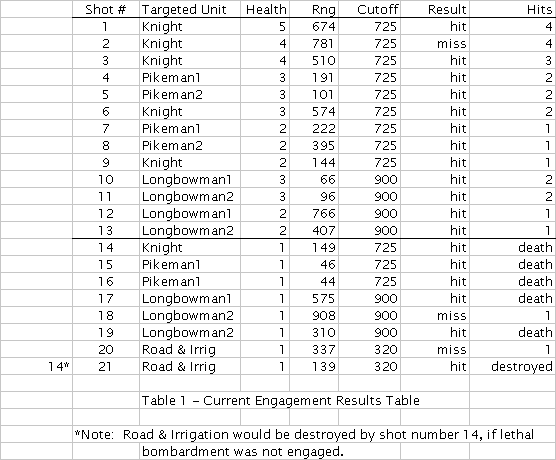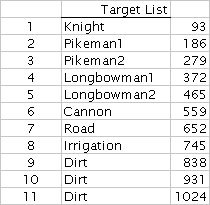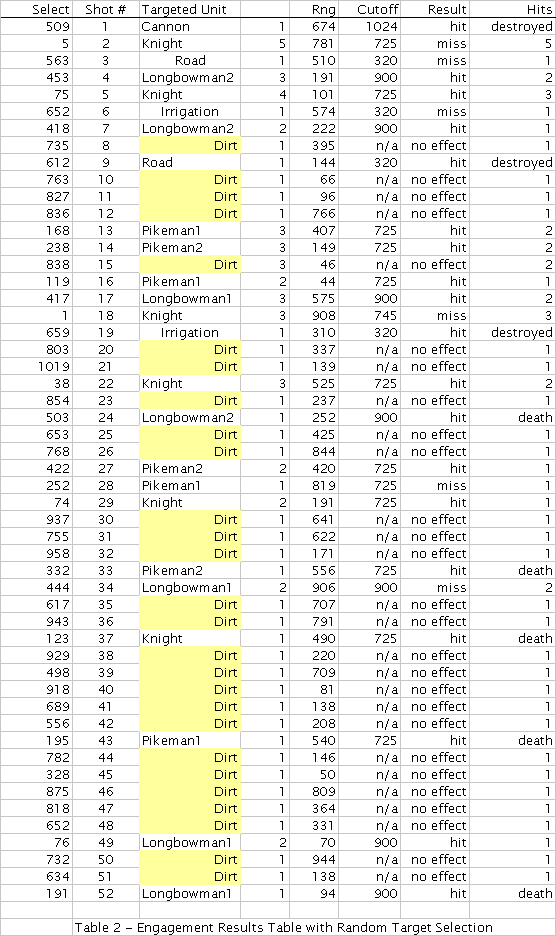cracker
Gil Favor's Sidekick
We need to continue a discussion that focuses attention on getting the bombardment engagement system in the out-of-the-box as patched version of CIV3 fixed to be a functional set of tools. These fixes need to be a near term patch without waiting for 6 more months for the XP version.
The key issues must emphasize having the correct features set to ON in the standard product and not just taking refuge in the fact that the feature can be turned on in the editor if you want to.
We need to acknowledge that there is a fairly strong lobbying group that has helped to render stand-off style engagements as fairly ineffective because this group of engagements has been saddled with the unfortunate label of bombardment. Just because these engagements are labeled as bombardment does not mean that they are strictly simulations of the ineffectiveness of WWI era artillery against entrenched defenders.
The current system of stand-off engagements (labeled bombardment) has tried to balance a limited number of variables to result in measured ineffectiveness for the stand-off attacker. A fundamental problem in the current implementation is that it relies on a deterministic system of target selection to reflect a statistical engagement process. What I mean by indicating that the engagement system is wrong to use the deterministic process is that when you fire a bombardment weapon at a stack of targets in a given terrain square, the current engagement system is certain to try and engage the strongest defender with zero chance of effecting any other units or features in the square. (note that in towns and cities this deterministic selection is modified to split the targeting between improvements, citizens, and defenders but it is still deterministic and not statistical).
The first key change that must be implemented is to expand the list of targets for stand-off engagements to include ALL units, improvements, citizens, and terrain features in a targeted terrain square. Everything should be a target and that is part of the risk of standoff attack methods.
Getting the potential target list correctly implemented will immediately have several significant and positive effects on stand-off type engagements. First, the expanded target list will include all the units that currently are exempt from being hit by the effects of bombardment weapons. Artillery and planes should be able to be hit by incoming attacks within the statistical limits of taking their chances among all the other potential targets. Workers, settlers, scouts, explorers, and other non-combatant units should be able to be damaged by stand-off attacks just like the citizens tilling the soil within a city or town. Fundamental in this potential target list is the concept of including the terrain square as number of potential targets in order to facilitate a statistical engagement process that recognizes that it is hard to get a hit against a single defending unit but relatively easy to get at least one hit against a stack of 40 or 50 targets in a single square.
By way of a simple example focused on potential target lists only, we can look at the case of a single spearman standing in the open on a roaded and irrigated plains square defending a worker and a catapult. In the current system, when we engage that the contents of that square with a standoff attack by a catapult, we are absolutely certain that the spearman will be targeted for attack and there is a 67% chance that the catapult will get a hit on the spearman. This is patently unrealistic. In the proposed, statistical system when we engage the targeted square we would have a potential target list of 8 targets (spearman, worker, catapult, road, irrigation, 3 x Terrain) so even without considering defensive strengths there would only be a 12.5% chance of getting a hit on the spearman but this would be balanced by knowing there would be a 62.5% chance of hitting something other than dirt. If this same example included 25 spearmen as might appear in an AI generated stack of doom (SoD) then the probability of hitting the strongest spearman would be only 3% but the overall probability of getting a hit would be 91% because there are just way to many targets in the square to not have an increased chance of getting a hit.
A second key impact of getting the potential target list properly expanded to include all potential targets will be a shift in the statistical approach that tries to force the standoff attack to miss the primary defender a significant number of times instead of allowing the system to miss the primary defender using random statistical failure. When more targets are recognized as being available, the chance of getting a hit of any kind will be higher but the chance of hitting and/or killing any specific target will be much lower, just as it should be.
After getting the potential target list properly expanded, the implementation of the impact of Rate of Fire should be distributed to allow multiple targets to be hit in a single engagement. This decision moves the process further towards reality and helps to spread out the damage from the standoff attack across all the potential targets to avoid the current overwhelming power against a single target. It would still be possible to get multiple hits on a single target in a single turn, but now the process would be statistical based on the number and strength of other potential targets. Instead on focusing on the destruction of a single unit as is currently implemented, the proposed stand-off attacks would focus on reducing the effectiveness of whole groups of attacking or defending forces.
Units which engage in stand-off attacks should have their hit success rate modified geometrically to correspond to their experience level. Every other combat unit in the game has some benefit associated with the level of experience of the unit. Bombardment engagements should be no different in that respect and elite bombardment units should be expected to be more successful in inflicting damage on the enemy units when compared to the success rate of their conscript, regular, or veteran peers of the same type.
All forms of standoff engagement should include the potential for lethality, but the impact of this decision will be substantially mitigated by the statistical redistribution of the attack power across all the potential targets. In stacks of 25 or 30 defenders (or advancing attackers), the chance of lethal engagement would be statistically spread across all the hit points of all the potential targets in the stack. While it would be possible to destroy an individual unit with a limited number of lethal stand-off attack engagements, it is far more likely to continue to require massed numbers of artillery and/or bombers to generate a lethal event. In a stack of 10 regular spearmen standing in the open on a roaded and irrigated plains square each spearman would have only a 1 in 15 chance of being the potential target for a catapult attack, and then the catapult would have only a 67% chance (4 vs 2) chance of hitting the spearman for an overall risk of 4.4%. If you fired three catapults at the stack that would be the minimum number of catapults required to potentially kill a spearman but there would only be a 1 in 1,139,000 chance of killing any of the units. You would have to have over 30 catapults lined up and firing on the stack of spearmen in order to have a 50/50 chance of killing just one spearman if the proposed rules were implemented.
A further enhancement to the lethal bombardment option could add displacement as a coin toss option for units that might otherwise be destroyed by the lethal effects of an incoming attack. The move it or loose it option would disrupt attacks and further expose the enemy forces to the selective effects of focused counter attacks and this should be exactly how non-precision stand off attacks should function
A key point in continuing to advocate for eliminating the deterministic engagement rules for stand-off attacks would be that some units do not get hit by bombardment because they get lucky combined with their defensive strength and health. Other units get hit and killed because they are unlucky combined with their weaker defensive strength and lower units health (morale).
Everything we attempt to do with units that use stand-off attack methods is just a series of band-aids and work-arounds until we get these three elements of the bombardment engagement system properly implemented to facilitate balanced usage of these types of engagement strategies.
The availability of appropriately functional bombardment units is key to supporting strategies that emphasize numerically limited military forces that use technology appropriately to disperse numerically excessive but obsolete armies that are overly concentrated into limited terrain features.
The key issues must emphasize having the correct features set to ON in the standard product and not just taking refuge in the fact that the feature can be turned on in the editor if you want to.
We need to acknowledge that there is a fairly strong lobbying group that has helped to render stand-off style engagements as fairly ineffective because this group of engagements has been saddled with the unfortunate label of bombardment. Just because these engagements are labeled as bombardment does not mean that they are strictly simulations of the ineffectiveness of WWI era artillery against entrenched defenders.
The current system of stand-off engagements (labeled bombardment) has tried to balance a limited number of variables to result in measured ineffectiveness for the stand-off attacker. A fundamental problem in the current implementation is that it relies on a deterministic system of target selection to reflect a statistical engagement process. What I mean by indicating that the engagement system is wrong to use the deterministic process is that when you fire a bombardment weapon at a stack of targets in a given terrain square, the current engagement system is certain to try and engage the strongest defender with zero chance of effecting any other units or features in the square. (note that in towns and cities this deterministic selection is modified to split the targeting between improvements, citizens, and defenders but it is still deterministic and not statistical).
The first key change that must be implemented is to expand the list of targets for stand-off engagements to include ALL units, improvements, citizens, and terrain features in a targeted terrain square. Everything should be a target and that is part of the risk of standoff attack methods.
Getting the potential target list correctly implemented will immediately have several significant and positive effects on stand-off type engagements. First, the expanded target list will include all the units that currently are exempt from being hit by the effects of bombardment weapons. Artillery and planes should be able to be hit by incoming attacks within the statistical limits of taking their chances among all the other potential targets. Workers, settlers, scouts, explorers, and other non-combatant units should be able to be damaged by stand-off attacks just like the citizens tilling the soil within a city or town. Fundamental in this potential target list is the concept of including the terrain square as number of potential targets in order to facilitate a statistical engagement process that recognizes that it is hard to get a hit against a single defending unit but relatively easy to get at least one hit against a stack of 40 or 50 targets in a single square.
By way of a simple example focused on potential target lists only, we can look at the case of a single spearman standing in the open on a roaded and irrigated plains square defending a worker and a catapult. In the current system, when we engage that the contents of that square with a standoff attack by a catapult, we are absolutely certain that the spearman will be targeted for attack and there is a 67% chance that the catapult will get a hit on the spearman. This is patently unrealistic. In the proposed, statistical system when we engage the targeted square we would have a potential target list of 8 targets (spearman, worker, catapult, road, irrigation, 3 x Terrain) so even without considering defensive strengths there would only be a 12.5% chance of getting a hit on the spearman but this would be balanced by knowing there would be a 62.5% chance of hitting something other than dirt. If this same example included 25 spearmen as might appear in an AI generated stack of doom (SoD) then the probability of hitting the strongest spearman would be only 3% but the overall probability of getting a hit would be 91% because there are just way to many targets in the square to not have an increased chance of getting a hit.
A second key impact of getting the potential target list properly expanded to include all potential targets will be a shift in the statistical approach that tries to force the standoff attack to miss the primary defender a significant number of times instead of allowing the system to miss the primary defender using random statistical failure. When more targets are recognized as being available, the chance of getting a hit of any kind will be higher but the chance of hitting and/or killing any specific target will be much lower, just as it should be.
After getting the potential target list properly expanded, the implementation of the impact of Rate of Fire should be distributed to allow multiple targets to be hit in a single engagement. This decision moves the process further towards reality and helps to spread out the damage from the standoff attack across all the potential targets to avoid the current overwhelming power against a single target. It would still be possible to get multiple hits on a single target in a single turn, but now the process would be statistical based on the number and strength of other potential targets. Instead on focusing on the destruction of a single unit as is currently implemented, the proposed stand-off attacks would focus on reducing the effectiveness of whole groups of attacking or defending forces.
Units which engage in stand-off attacks should have their hit success rate modified geometrically to correspond to their experience level. Every other combat unit in the game has some benefit associated with the level of experience of the unit. Bombardment engagements should be no different in that respect and elite bombardment units should be expected to be more successful in inflicting damage on the enemy units when compared to the success rate of their conscript, regular, or veteran peers of the same type.
All forms of standoff engagement should include the potential for lethality, but the impact of this decision will be substantially mitigated by the statistical redistribution of the attack power across all the potential targets. In stacks of 25 or 30 defenders (or advancing attackers), the chance of lethal engagement would be statistically spread across all the hit points of all the potential targets in the stack. While it would be possible to destroy an individual unit with a limited number of lethal stand-off attack engagements, it is far more likely to continue to require massed numbers of artillery and/or bombers to generate a lethal event. In a stack of 10 regular spearmen standing in the open on a roaded and irrigated plains square each spearman would have only a 1 in 15 chance of being the potential target for a catapult attack, and then the catapult would have only a 67% chance (4 vs 2) chance of hitting the spearman for an overall risk of 4.4%. If you fired three catapults at the stack that would be the minimum number of catapults required to potentially kill a spearman but there would only be a 1 in 1,139,000 chance of killing any of the units. You would have to have over 30 catapults lined up and firing on the stack of spearmen in order to have a 50/50 chance of killing just one spearman if the proposed rules were implemented.
A further enhancement to the lethal bombardment option could add displacement as a coin toss option for units that might otherwise be destroyed by the lethal effects of an incoming attack. The move it or loose it option would disrupt attacks and further expose the enemy forces to the selective effects of focused counter attacks and this should be exactly how non-precision stand off attacks should function
A key point in continuing to advocate for eliminating the deterministic engagement rules for stand-off attacks would be that some units do not get hit by bombardment because they get lucky combined with their defensive strength and health. Other units get hit and killed because they are unlucky combined with their weaker defensive strength and lower units health (morale).
Everything we attempt to do with units that use stand-off attack methods is just a series of band-aids and work-arounds until we get these three elements of the bombardment engagement system properly implemented to facilitate balanced usage of these types of engagement strategies.
The availability of appropriately functional bombardment units is key to supporting strategies that emphasize numerically limited military forces that use technology appropriately to disperse numerically excessive but obsolete armies that are overly concentrated into limited terrain features.





